Book Announcements
Auschwitz Engineers in Moscow
Authored by Carlo Mattogno
Carlo Mattogno, Auschwitz Engineers in Moscow: The Soviet Postwar Interrogations of the Auschwitz Cremation-Furnace Engineers. The Statements of Kurt Prüfer, Karl Schultze, Fritz Sander and Gustav Braun on “Gas Chambers” and Cremation Furnaces at Auschwitz, 270 pages, index, bibliography, ISBN: 978-1-911733-10-2; Armreg Ltd, London, 2024.
Carlo Mattogno submitted an early typescript of this book already in February of 2014, hence ten years ago. At that point in time, the series Holocaust Handbooks was published by The Barnes Review, whose chief editor was not too keen on a book project that focused on a tiny aspect of Auschwitz history which may find the interest of only a few specialists in the field at best. Therefore, the project got shelved.
In late 2023, Mattogno submitted a revised and expanded version of it, and this time we couldn’t say no. This is Volume 52 of our prestigious series Holocaust Handbooks. Print and eBook versions of the current English edition can be obtained from Armreg Ltd at armreg.co.uk.
The introduction to this book is reproduced earlier in this issue of Inconvenient History.
After the end of World War Two, the Soviets arrested four leading engineers of the engineering company J.A. Topf & Sons. Among other things, they had planned and supervised the construction of the Auschwitz cremation furnaces and the ventilation systems of the rooms said to have served as homicidal gas chambers. Between 1946 and 1948, Soviet officials conducted numerous interrogations with them.
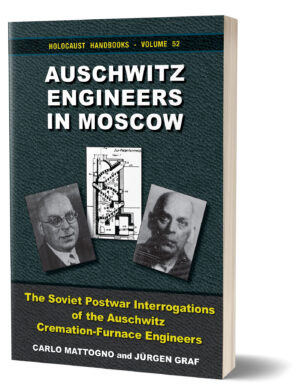 The protocols of these interrogations were discovered in a Russian archive in 1993. Several mainstream scholars have since pointed out that the Topf engineers confessed during their interrogations to have willingly assisted in the construction of homicidal gas chambers, and in building the cremation furnaces to dispose of the bodies of those murdered. However, these scholars blatantly ignore the fact that, with their cruel incarceration and interrogation methods, Soviet interrogators always managed to extract any desired confession from any defendant. This is reflected here by the fact that the Topf engineers had adopted the Soviet’s anti-fascist polemical terms, and often simply repeated in the affirmative the loaded questions they had been asked.
The protocols of these interrogations were discovered in a Russian archive in 1993. Several mainstream scholars have since pointed out that the Topf engineers confessed during their interrogations to have willingly assisted in the construction of homicidal gas chambers, and in building the cremation furnaces to dispose of the bodies of those murdered. However, these scholars blatantly ignore the fact that, with their cruel incarceration and interrogation methods, Soviet interrogators always managed to extract any desired confession from any defendant. This is reflected here by the fact that the Topf engineers had adopted the Soviet’s anti-fascist polemical terms, and often simply repeated in the affirmative the loaded questions they had been asked.
This work analyzes these interrogations by putting them into the context of the vast documentation on the Auschwitz crematoria and related facilities. It shows that every single “confession” of the Topf engineers contradicts both established facts and even the orthodox narrative: For example, their description of the alleged “gas chambers” and how they supposedly operated is completely wrong. They claimed mass gassings of Greek Jews for the summer of 1942, although the first Greek Jews arrived at Auschwitz only in March 1943. They insisted that, due to a lack of corpses, they could test the Birkenau furnaces in early 1943 only after waiting several days for the victims of a mass gassing. However, during that time, hundreds of inmates died every day of a raging typhus epidemic, so there was no shortage of bodies to cremate, hence no need to wait. Furthermore, allegedly because the existing crematoria proved to be insufficient, one of the engineers claimed to have invented, in the summer of 1942, a mass-cremation device for industrial-style mass murder. However, that invention was made at the peak of the catastrophic typhus epidemic in Auschwitz, many months before the Birkenau crematoria were built, and the patent application for the device clearly speaks of the sanitary disposal of the victims of infectious diseases, not mass murder.
Interestingly, when it comes to things the Topf engineers were intimately familiar with, they told the truth: they described the properties and performance of their cremation devices accurately, independently confirming that they could cremated only roughly one body per hour and muffle, and that attempts at cremating multiple bodies at once did not have any advantageous result. This pulls the rug out from underneath the orthodox narrative.
The Book of the Shulchan Aruch
Authored by Erich Bischoff
Erich Bischoff, The Book of the Shulchan Aruch, 152 pages, ISBN: 979-8986-7250-86; Clemens & Blair, New York/Castle Hill Publishers, Bargoed, UK, February 2023.
There has been some disagreement among the members of the CODOH Board of Trustees whether or not Castle Hill should be the co-publisher of this book. Those opposed argued that CODOH is for open debate on the Holocaust, not on Jewish religious issues. Those in favor argued that this book had considerable influence on how German intellectuals in the 1930 and early 1940s saw the Jewish religion and thus the Jews themselves. It served as a “justification” for measures taken against Jews, whatever those were. Hence, any attempt at understanding why the National Socialist persecuted the Jews the way they did would be incomplete when ignoring this book. It is therefore of prime importance for historical understanding.
The book should have been announced in the first issue of 2023, but at that point, Castle Hill was not even carrying it. When it was included in Castle Hill’s program a few months later by reselling copies printed by Clemens & Blair, it was not considered a Castle Hill product. That changed only in late 2023, when Castle Hill produced its own edition with new cover artwork. However, around that time, things went haywire at Castle Hill. Only now, under Armreg’s resurrection of Castle Hill’s book program, was the project dusted of and put in the showcase. Print and eBook versions of the current English edition can be obtained from Armreg Ltd at armreg.co.uk.
The introduction to this book by Thomas Dalton is reproduced earlier in this issue of Inconvenient History.
Perhaps no book is less known, yet more important, than the Shulchan Aruch. Most people have heard of the Talmud – that compendium of Jewish laws, and thus the essence of Judaism. The Talmud, however, is vast and largely inscrutable for non-Jews. Fortunately, back in the mid-1500s, a Jewish rabbi named Joseph Karo decided to create a condensed, compact version of the Talmud. He called it ‘the set table’: the Shulchan Aruch.
 Most of the Shulchan Aruch deals with inter-Jewish laws, but a fair number of passages discuss non-Jews – the Gentiles, or in less polite terms, the ‘goyim.’ As it happens, the laws of Judaism hold Gentiles in very low regard; they can be cheated, lied to, abused, even killed, if it serves Jewish interests. Jewish supremacy reigns throughout the Talmud and the Shulchan Aruch.
Most of the Shulchan Aruch deals with inter-Jewish laws, but a fair number of passages discuss non-Jews – the Gentiles, or in less polite terms, the ‘goyim.’ As it happens, the laws of Judaism hold Gentiles in very low regard; they can be cheated, lied to, abused, even killed, if it serves Jewish interests. Jewish supremacy reigns throughout the Talmud and the Shulchan Aruch.
In Weimar Germany, a German scholar of religion and the Hebrew language named Erich Bischoff decided to write a summary and analysis of this most-important of books. In 1929, he published Das Buch vom Schulchan Aruch – the present work is translated from the 1942 edition. Never before or since has a knowledgeable scholar conducted such an honest and critical study. Here, we see many dark corners of the Jewish religion exposed; here, we see exactly how Jews view the contemptible goyim.
This book is invaluable for all those interested in cutting through the fog and obscurity of the Talmud, and in getting to the heart of Jewish thinking and Jewish attitudes: the Shulchan Aruch.
Miscellaneous Books
When creating audio files for all entries of the Holocaust Encyclopedia using neural-network text-to-speech software, I discovered that listening to a text being read by a machine is a very efficient way of proofing the text. The software, no matter how “intelligent,” never misses to read a mistake as it is (mis)typed, making the attentive listener cringe, and plows without hesitation even through difficult-to-understand or nonsensical passages, making the listener stop the playback in confusion, realizing that this passage needs to be rewritten. Comparing the error-discovery rate of this method with that of even professional and experienced editors has shown that computers are noticeably better at inadvertently revealing issues requiring a fix.
With that lesson learned, and with Castle Hill having suspended business activities, Armreg, with a license granted by Castle Hill, launched an ambitious project to turn the most important revisionist texts into audio books, while simultaneously fixing all bumps in the text flow that needed correction, and updating anything that was outdated. This project has so far resulted in the following books having been converted into audio books, plus new print and eBook editions as synergistic byproducts:
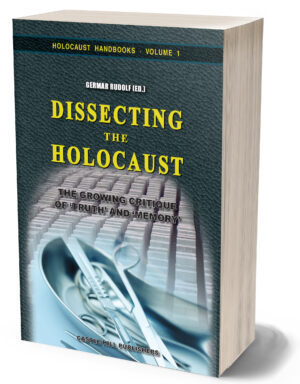 Germar Rudolf (ed), Dissecting the Holocaust, 4th edition (February 2024)
Germar Rudolf (ed), Dissecting the Holocaust, 4th edition (February 2024)
The last update to this book had been released only in late 2019, so there was not all that much in need of a fix, but since Armreg had to issue a new edition with its own ISBN number and imprint anyway, a new edition with a few updates was released. If you already own the 2019 print edition, it is probably not worth getting the new print edition. The eBook edition, however, can always be downloaded free of charge from www.HolocaustHandbooks.com, and that’s probably worth the effort. The audio-book version can be downloaded there as well.
Print, audio and eBook versions of the current edition of this book can be obtained from Armreg Ltd at armreg.co.uk.
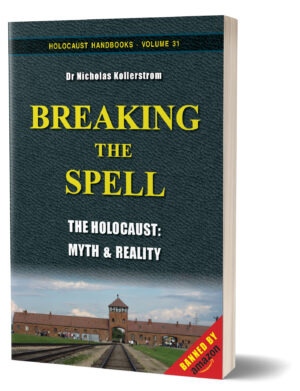 Nicholas Kollerstrom, Breaking the Spell, 7th edition (February 2024)
Nicholas Kollerstrom, Breaking the Spell, 7th edition (February 2024)
Although Castle Hill had released a new edition of this book just a year ago, converting this bestseller among revisionist books into an audio book was at the top of our list. In this case, it is only the audio version that is really new. The new print edition again merely served to sever ties from the sinking ship Castle Hill.
The eBook and audio versions can be downloaded free of charge at www.HolocaustHandbooks.com. Print, audio and eBook versions can be obtained from Armreg Ltd at armreg.co.uk.
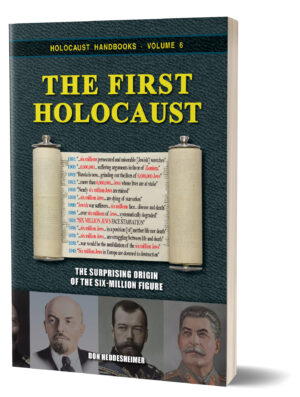
Don Heddesheimer, The First Holocaust, 3rd edition (March 2024)
The last, 5th edition of this book had been released in 2018, and thus its source references were in need of some major updates. The book’s lengthy introduction already exists as a video (or rather, that 2016 video narration was turned into the book’s new introduction for the 4th edition of 2017). Therefore, an audio version may have been not needed in a strict sense. But because this book is quite significant in terms sales success and pedagogical value, we made it a priority anyhow.
The eBook and audio versions can be downloaded free of charge at www.HolocaustHandbooks.com. Print, audio and eBook versions can be obtained from Armreg Ltd at armreg.co.uk.
Armreg moreover released its first-ever revisionist book in Spanish:
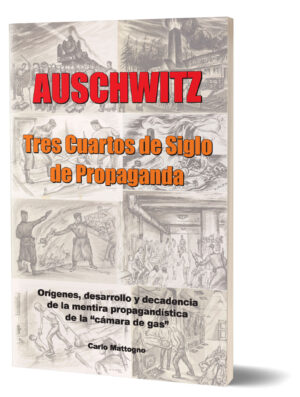 Carlo Mattogno, Auschwitz: Tres Cuartos de Siglo de Propaganda: Orígenes, desarrollo y decadencia de la mentira propagandística de la “cámara de gas”, 1st Spanish edition (March 2024)
Carlo Mattogno, Auschwitz: Tres Cuartos de Siglo de Propaganda: Orígenes, desarrollo y decadencia de la mentira propagandística de la “cámara de gas”, 1st Spanish edition (March 2024)
This is the equivalent to Mattogno’s bestselling book Auschwitz: A Three-quarter Century of Propaganda. We had a translation of this book ready to go since early 2023, but with Castle Hill being in no position to push the boundaries, it was shelved. Armreg has now revived it, and dares to venture into the Hispanic realm. It even comes with an audio-book version. A few more books are also poised to hit the market, but due to a lack of native speakers editing at affordable rates, things progress somewhat slowly.
Print, audio and eBook versions can be obtained from Armreg Ltd at armreg.co.uk.
Bibliographic information about this document: Inconvenient History, 2024, Vol. 16, No. 1
Other contributors to this document:
Editor’s comments:
